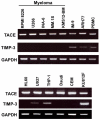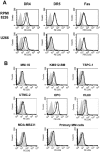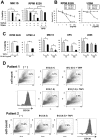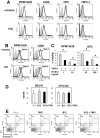Inhibition of TACE activity enhances the susceptibility of myeloma cells to TRAIL
- PMID: 22389670
- PMCID: PMC3289627
- DOI: 10.1371/journal.pone.0031594
Inhibition of TACE activity enhances the susceptibility of myeloma cells to TRAIL
Abstract
Background: TNF-related apoptosis-inducing ligand/Apo2 ligand (TRAIL/Apo2L) selectively induces apoptosis in various cancer cells including myeloma (MM) cells. However, the susceptibility of MM cells to TRAIL is largely low in most of MM cells by yet largely unknown mechanisms. Because TNF-α converting enzyme (TACE) can cleave some TNF receptor family members, in the present study we explored the roles of proteolytic modulation by TACE in TRAIL receptor expression and TRAIL-mediated cytotoxicity in MM cells.
Methodology/principal findings: MM cells preferentially expressed death receptor 4 (DR4) but not DR5 on their surface along with TACE. Conditioned media from RPMI8226 and U266 cells contained a soluble form of DR4. The DR4 levels in these conditioned media were reduced by TACE inhibition by the TACE inhibitor TAPI-0 as well as TACE siRNA. Conversely, the TACE inhibition restored surface levels of DR4 but not DR5 in these cells without affecting DR4 mRNA levels. The TACE inhibition was able to restore cell surface DR4 expression in MM cells even in the presence of bone marrow stromal cells or osteoclasts, and enhanced the cytotoxic effects of recombinant TRAIL and an agonistic antibody against DR4 on MM cells.
Conclusions/significance: These results demonstrate that MM cells post-translationally down-modulate the cell surface expression of DR4 through ectodomain shedding by endogenous TACE, and that TACE inhibition is able to restore cell surface DR4 levels and the susceptibility of MM cells to TRAIL or an agonistic antibody against DR4. Thus, TACE may protect MM cells from TRAIL-mediated death through down-modulation of cell-surface DR4. It can be envisaged that TACE inhibition augments clinical efficacy of TRAIL-based immunotherapy against MM, which eventually becomes resistant to the present therapeutic modalities.
Conflict of interest statement
Figures





Similar articles
-
Membrane expression of DR4, DR5 and caspase-8 levels, but not Mcl-1, determine sensitivity of human myeloma cells to Apo2L/TRAIL.Exp Cell Res. 2007 Jul 1;313(11):2378-88. doi: 10.1016/j.yexcr.2007.03.018. Epub 2007 Mar 30. Exp Cell Res. 2007. PMID: 17462628
-
H-Ras regulation of TRAIL death receptor mediated apoptosis.Oncotarget. 2014 Jul 15;5(13):5125-37. doi: 10.18632/oncotarget.2091. Oncotarget. 2014. PMID: 25026275 Free PMC article.
-
Reactivation of death receptor 4 (DR4) expression sensitizes medulloblastoma cell lines to TRAIL.J Neurooncol. 2009 Jul;93(3):303-18. doi: 10.1007/s11060-008-9788-x. Epub 2009 Jan 16. J Neurooncol. 2009. PMID: 19148581 Free PMC article.
-
Antibodies and Derivatives Targeting DR4 and DR5 for Cancer Therapy.Antibodies (Basel). 2017 Oct 25;6(4):16. doi: 10.3390/antib6040016. Antibodies (Basel). 2017. PMID: 31548531 Free PMC article. Review.
-
Chemical synthetic approaches to mimic the TRAIL: promising cancer therapeutics.RSC Med Chem. 2024 Aug 1;15(11):3639-51. doi: 10.1039/d4md00183d. Online ahead of print. RSC Med Chem. 2024. PMID: 39246747 Free PMC article. Review.
Cited by
-
Role of ADAM10 and ADAM17 in Regulating CD137 Function.Int J Mol Sci. 2021 Mar 8;22(5):2730. doi: 10.3390/ijms22052730. Int J Mol Sci. 2021. PMID: 33800462 Free PMC article.
-
Formononetin isolated from Sophorae flavescentis inhibits B cell-IgE production by regulating ER-stress transcription factor XBP-1.Front Allergy. 2023 Feb 1;3:1056203. doi: 10.3389/falgy.2022.1056203. eCollection 2022. Front Allergy. 2023. PMID: 36816476 Free PMC article.
-
Inhibition of Myeloma Cell Function by Cannabinoid-Enriched Product Associated With Regulation of Telomere and TP53.Integr Cancer Ther. 2024 Jan-Dec;23:15347354241267979. doi: 10.1177/15347354241267979. Integr Cancer Ther. 2024. PMID: 39256983 Free PMC article.
-
Multiple mechanisms contribute to acquired TRAIL resistance in multiple myeloma.Cancer Cell Int. 2024 Aug 5;24(1):275. doi: 10.1186/s12935-024-03466-3. Cancer Cell Int. 2024. PMID: 39098932 Free PMC article.
-
TAK1 inhibition subverts the osteoclastogenic action of TRAIL while potentiating its antimyeloma effects.Blood Adv. 2017 Oct 26;1(24):2124-2137. doi: 10.1182/bloodadvances.2017008813. eCollection 2017 Nov 14. Blood Adv. 2017. PMID: 29296860 Free PMC article.
References
-
- Gonzalvez F, Ashkenazi A. New insights into apoptosis signaling by Apo2L/TRAIL. Oncogene. 2010;29:4752–4765. - PubMed
-
- Johnstone RW, Frew AJ, Smyth MJ. The TRAIL apoptotic pathway in cancer onset, progression and therapy. Nat Rev Cancer. 2008;8:782–798. - PubMed
-
- Mellier G, Huang S, Shenoy K, Pervaiz S. TRAILing death incancer. Mol Aspects Med. 2010;31:93–112. - PubMed
-
- Wiezorek J, Holland P, Graves J. Death receptor agonists as a targeted therapy for cancer. Clin Cancer Res. 2010;16:1701–1708. - PubMed
-
- Moretto P, Hotte SJ. Targeting apoptosis: preclinical and early clinical experience with mapatumumab, an agonist monoclonal antibody targeting TRAIL-R1. Expert Opin Investig Drugs. 2009;18:311–325. - PubMed
Publication types
MeSH terms
Substances
LinkOut - more resources
Full Text Sources
Other Literature Sources
Medical
Miscellaneous

